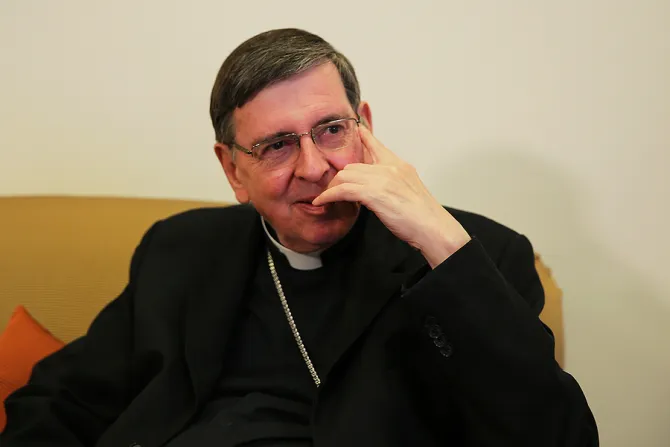Rome, Italy, Sep 27, 2016 / 23:34 pm
Hundreds of years before Martin Luther broke away from the Roman Catholic Church and the Pope in the western world, the Great Eastern Schism created a division between Rome and Constantinople.
The split of Christianity in the Orthodox churches of the east and the Roman Catholic Church in the west was formally completed in the year 1054. On December 7, 1965, Pope Paul VI in Rome and the ecumenical Patriarch Athenagoras in Istanbul terminated the mutual excommunications "from memory and from the midst of the Church" and committed them "to oblivion."
But efforts toward healing have taken place. Upon the invitation of Archbishop Bruno Forte from Chieti-Vasto, Italy, 70 Orthodox bishops together with two cardinals and numerous other high clergymen of the Roman Catholic Church celebrated the Orthodox "divine liturgy" of St. John Chrysostom on September 18, 2016 in the Basilica of the Holy Face before the Face of Christ, which is displayed above the main altar of the church.
CNA / EWTN News Rome correspondent Paul Badde asked Cardinal Kurt Koch, president of the Pontifical Council for Promoting Christian Unity, about the celebration:
CNA: Your Eminence, Archbishop Bruno Forte calls the "Holy Face" of Christ the "polar star of Christianity." For him, there is no rational doubt that the veil with the image is identical to Veronica's veil of Christ that John mentions next to the linen bandages in the holy tomb. Is that however not provocative for the Orthodox brothers?
Cardinal Koch: Christians believe in one God who showed his concrete face in Jesus Christ. And the closer we come to know to the Face of Christ and the deeper we become one in him, the deeper we also become one among ourselves. Therefore, it is a wonderful occasion to be before the face of Christ, to pray, to venerate the Face in order to ask for his wish to be fulfilled that we find unity.
Catholics have something to bring the Orthodox. The other way around is also true, with the Orthodox, say with their culture of venerating icons. Could it be this: that from this day on, the images could be newly comprehended and valued in the Catholic Church – in the midst of that powerful "Iconic Turn," which the media experts today observe how images in general play a role in communication like never before?
Yes, the innermost mystery of ecumenism is an exchange of gifts. Every church has their gifts. And the icons are a special gift of Orthodoxy. I believe therefore that many Christians in the west can find a new approach to the icons and so deepen their faith. That is a magnificent gift. It is very important that we in the western tradition also renew our appreciation for the image. Through the reformation in the 16th century, we set a totally new emphasis on the word. But the Word was made flesh. The Word was made visible. Therefore the images belong with faith. That is a gift of the Orthodox that we accept gratefully.
Ten years ago, Peter, in the form of Pope Benedict, came here. Since then, there has been a tremendous turn in the appreciation of this image of Manoppello. Since then, it has become world-renown. Today, the Synod of Bishops came. What meaning do you think will someday be attributed to this pilgrimage in which the Synod convened here?
It is very nice that after 10 years we were allowed to come here on this jubilee. Pope Benedict came in the name of the whole Catholic Church. Today the Church from east and west is present here. This jubilee can perhaps aid the search for unity between the Church in the east and the Church in the west.
You are, as president of the Pontifical Council for Promoting Christian Unity in Rome, responsible for ecumenism. Pope Francis has said, "Look at Christ and proceed courageously!" What would you say in light of today, when you came together in this difference of the eastern and western Church before this image of Christ, would be the next step to approach Christ courageously?
We are actually always on the way towards Christ. For it is His Will that we find unity. That is not a human project. Christ himself prayed on the evening before his suffering that the disciples would be one so that the world would believe. The credibility of witness depends on our being one. That is also a special concern of Pope Francis when he says we must go the same way towards Christ, then we will find the unity.
"Misericordiae Vultus" (The Face of Mercy) is the name of the bull of indiction with which Pope Francis announced this Holy Year of Mercy. The "Face of Mercy" was given this year its very own meaning. What do you feel when you stand here today before the merciful glance of Christ, who looks at us from this wonderful veil?
It is a beautiful message that we have a merciful God, who knows that there are no hopeless causes for him. Even if a person has fallen so deeply, he can never fall deeper than into the hands of God. To be able to now really see this face and encounter it is of course a wonderful immersion into this message of the holy year. People today need nothing more than God's mercy. And if they may look at the face of the merciful God, that is a wonderful gift.
And what will you tell Pope Francis about this occasion if you get the chance?
I will certainly say to him that we have faced his great message of God's mercy and that this face is important for the whole Church. That is, so to say, the banner of the Church: the merciful face of God!
(Story continues below)
Translated by R. Andrew Krema



